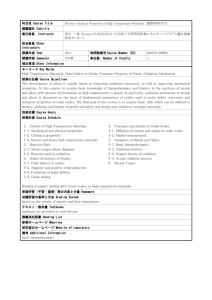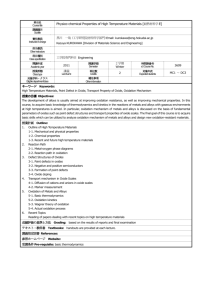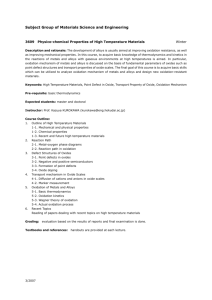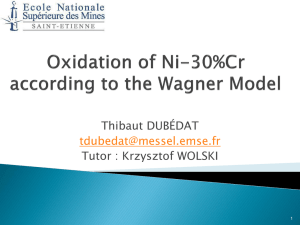Oxidation Properties of Alpha Brass Alloy By Aluminum Addition
advertisement
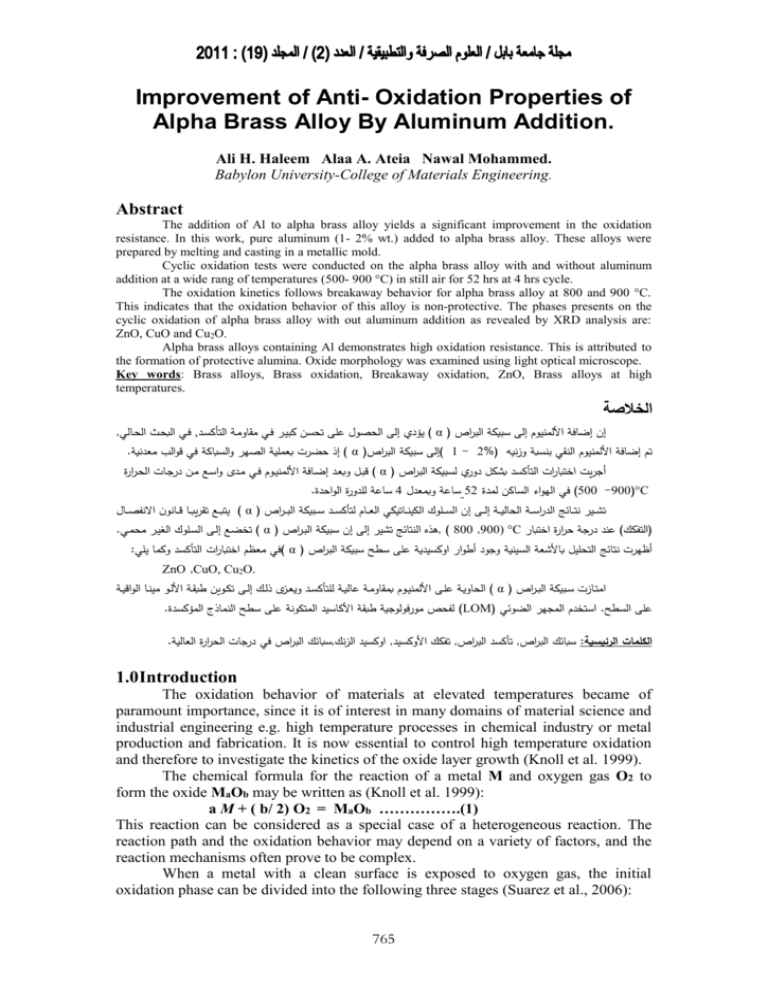
Improvement of Anti- Oxidation Properties of Alpha Brass Alloy By Aluminum Addition. Ali H. Haleem Alaa A. Ateia Nawal Mohammed. Babylon University-College of Materials Engineering. Abstract The addition of Al to alpha brass alloy yields a significant improvement in the oxidation resistance. In this work, pure aluminum (1- 2% wt.) added to alpha brass alloy. These alloys were prepared by melting and casting in a metallic mold. Cyclic oxidation tests were conducted on the alpha brass alloy with and without aluminum addition at a wide rang of temperatures (500- 900 °C) in still air for 52 hrs at 4 hrs cycle. The oxidation kinetics follows breakaway behavior for alpha brass alloy at 800 and 900 °C. This indicates that the oxidation behavior of this alloy is non-protective. The phases presents on the cyclic oxidation of alpha brass alloy with out aluminum addition as revealed by XRD analysis are: ZnO, CuO and Cu2O. Alpha brass alloys containing Al demonstrates high oxidation resistance. This is attributed to the formation of protective alumina. Oxide morphology was examined using light optical microscope. Key words: Brass alloys, Brass oxidation, Breakaway oxidation, ZnO, Brass alloys at high temperatures. الخالصة فرم الححرا الحرالم, ) يؤدي إلى الحصول على تحسن كبيرر فرم مواومرة التد سردα ( إن إضافة األلمنيوم إلى سبيكة البراص . ) إذ حضرت حعملية الصهر والسحا ة فم قوالب معدنيةα ( )إلى سبيكة البراص1 - 2%( تم إضافة األلمنيوم النوم بنسحة وزنيه ) قبرل وحعرد إضرافة األلمنيروم فرم مردا واسر مرن درجرات الحررارα ( أجريت اختحارات التد سد حشكل دوري لسبيكة البراص . ساعة للدور الواحد4 ساعة وحمعدل02 ) فم الهواء السا ن لمد099 -099(°C ) يتحر ر توريحررا ق ررانون ا ن ص ررالα ( تشررير نت ررارا الد ارسررة الحالي ررة إلررى إن الس ررلو ال ينرراتيكم الع ررام لتد سررد س رربيكة الب رراص . ) تخضر إلرى السرلو ال يرر محمرمα ( ) هذه النتارا تشير إلى إن سبيكة البرراص099 099) °C (الت ك ) عند درجة حرار اختحار : )فم معظم اختحارات التد سد وكما يلمα ( أظهرت نتارا التحليل حاألشعة السينية وجود أطوار اوكسيدية على سطح سبيكة البراص ZnO CuO, Cu2O. ) الحاويرة علرى األلمنيرروم حمواومرة عاليررة للتد سررد ويعررزا ذلر إلررى ت رروين طحورة األلررو مينرا الواقيررةα ( امترازت سرربيكة البرراص . ) ل حص مورفولوجية طحوة األ اسيد المت ونة على سطح النماذج المؤكسدLOM( استخدم المجهر الضورم.على السطح . سحار البراص تد سد البراص ت ك األوكسيد اوكسيد الزن سحار البراص فم درجات الحرار العالية:الكلمات الرئيسية 1.0Introduction The oxidation behavior of materials at elevated temperatures became of paramount importance, since it is of interest in many domains of material science and industrial engineering e.g. high temperature processes in chemical industry or metal production and fabrication. It is now essential to control high temperature oxidation and therefore to investigate the kinetics of the oxide layer growth (Knoll et al. 1999). The chemical formula for the reaction of a metal M and oxygen gas O2 to form the oxide MaOb may be written as (Knoll et al. 1999): a M + ( b/ 2) O2 = MaOb …………….(1) This reaction can be considered as a special case of a heterogeneous reaction. The reaction path and the oxidation behavior may depend on a variety of factors, and the reaction mechanisms often prove to be complex. When a metal with a clean surface is exposed to oxygen gas, the initial oxidation phase can be divided into the following three stages (Suarez et al., 2006): 765 Journal of Babylon University/Pure and Applied Sciences/ No.(2)/ Vol.(19): 2011 Starting with a clean surface, the initial step in the metal- oxygen reaction is the adsorption of the gas on the metal surface. As the reaction proceeds, individual separated oxide nuclei are formed on the surface which grows laterally to form a continuous oxide layer on the metal surface. Thus, the oxide layer separates the metal from the gas and the reaction mechanism changes completely. The reaction can only proceed by a solid- state diffusion of one or both of the reactants through the oxide layer. Brass is a metal alloy made from a combination of zinc and copper. Originally a sparkling goldish color, brass has a tendency to tarnish with age (Donald et al., 2003). Brass alloys have been choosing for its industrial importance in addition to its broad using in the electrical, marines, and other types of industries. Brass alloys are used in the heat exchangers of power plants. However, these alloys are suffering from oxidation problems especially at high temperature applications and also suffering from dezincification problems that accompanied with mechanical properties degradation (Wood, 1970). According to that, many efforts have been directed to improve the properties of the cheap one brass by alloying technique. The aluminum is one of the important alloying elements that have a great role in the improving oxidation resistance of brass alloys at the high temperature applications by forming a protective surface layer of (Al2 O3) (Powell et al., 2000). The aim of this work is to study the methods by which the oxidation resistance and thermal shock resistance are improved for the alpha brass alloy (70/ 30) by addition of pure aluminum with different weight percentages. 2.0 Experimental Work Alloys have been produced by melting and casting in a metallic mold with a diameter of 15 mm, aluminum added with different percentages (1, 1.25, 1.5, 1.75. and 2 wt.%). Analysis of this alloy was carried out using (spectrometer DV. 4) in AlNasser company. Table 1 shows the analytical chemical composition of the alloy used in this work A homogenous heat treatment has been conducted for the casted samples. A temperature of 550 °C for 6 hrs. have been choosing for homogenization process in order to minimize the casting defects and to get the required homogenized alloys. Alpha brass alloy samples with and without Al addition samples were cut into discs shape with dimensions of 10 mm as diameter and thickness of 3 mm. Small hole of 1 mm diameter was drilled in each sample for holding during oxidation tests. All surfaces, including the edges were wet ground using 120, 220, 320, 600, 800, and 1200 grit silicon carbide papers. All samples were then cleaned with water, degreased with acetone, and then ultrasonically cleaned for 30 minutes using ethanol as a medium. After drying, the samples were stored in polyethylene zip-lock bags. The dimensions of all samples were measured. The samples dimensions were measured in three places along the length to a precision 0.01 mm using a calibrated micrometer. The measured dimensions were averaged to provide the sample diameter, and thickness in order to be used in surface area calculation. The weight of each sample was measured using a Sartorius electronic balance with an accuracy of ± 0.1 mg. manufactured in Switzerland. The balance was calibrated frequently using standard weights. Prior to weighing, all samples were held overnight in glass dessicator in order to eliminate any effect of humidity on the sample weight determination. 766 Cyclic oxidation at extended range of temperature 500-900 oC in air were conducted to study the thermal shock and oxidation resistance of alpha brass alloys with and without aluminum additions. During cyclic oxidation the furnace temperature was controlled within 3 oC by using Ni-chrome thermocouple type K. The thermocouple was inserted into the furnace chamber through an access hole on the top of the furnace and positioned in the proximity of the samples. The thermocouple was calibrated at three standard temperatures boiling water, tin melting point, and aluminum melting point. The evaluation of the oxidation resistance of all alpha brass alloys with and without aluminum additions has been carried out by heating the samples in a furnace at test temperature and weighing them every 4 hrs. The samples were extracted from the furnace, allowed to cool, ultrasonically cleaned to detach the spalled oxide and the weight change per unit surface area was determined according to Paul et al. procedure (Paul et al., 2007). Alpha brass alloys with and without aluminum additions have been accurately weighed and then placed into ceramic crucibles. Cyclic oxidation tests were carried out in a chamber furnace type (Sola Basic S.B Lindbergh) in the temperature range 500-900 oC in air at one atmospheric pressure. Each heating cycle includes heating in the furnace at test temperature for 4 hrs and cooling in still air. Samples weight changes before and after each oxidation cycle were measured. Normally; at least 3 weight measurements were taken. To aid in the identification of oxide phases, X-ray diffraction was performed. A Riga Ku X-ray generator with Cu K radiation at 40 kV and 20 mA was used. The X-ray generated by general electric diffracto-meter, type Philips (pw 1840), operating at scanning speed of 6o (2 ) per minute. The detector was moved through angle of 2 = 10 to 90 degrees. 3.0 Results and Discussion 3.1 Oxidation of Alpha brass alloys Generally, the weight gain has increased for this alloy as the temperature increased as shown in Fig. 1 except at 900 oC case where spalling occurs just after two cycles. This is due to the increasing of diffusion rate at high temperature conditions, where the metal ions diffusion increasing in the direction of metal surface where the vacancies are increased at the interfacial surface and then accumulated to form voids. These voids in turn represents a separation sites for the oxide layer that form on the alloy surface (Figures 2 -5). Eventually these voids going to decrease the efficiency of the oxide layer and then the rate of oxidation will increased and the problem of dezincification will be arise (Kolarik et al., 2000). Its clear from Fig.1, that the rate of oxidation will be fast at the begging and then slowing down to reach a lower level. The reason behind such behavior is that all the binary alloys of copper behave like the copper oxidation which change from one mechanism to another according to the test temperature, whereas, the outer surface consists of CuO and the bulk consisting of alloy oxide (William, 2003). Further, thermal stresses develop as a result of wide changes in temperatures. When the temperature rise, there is a difference in the coefficient of thermal expansion between the metal and oxide layer, resulted in develop a tension and compression stresses with the temperature changes that leading to cracking the oxide layer and exfoliation. It's clear from Figures (2- 5), that the oxide layers are suffered from the problem of large cracking and exfoliation. This is obvious in large reduction in samples weight especially at 900 °C (Fig. 1). However, at 700°C the weight loses was 767 Journal of Babylon University/Pure and Applied Sciences/ No.(2)/ Vol.(19): 2011 not maintained but the sample begin to gain weight again after some period of weight loss. It is believed that the existence of cracks in the oxide layer would result in a rapid increase of the surface area in contact with oxygen and then accelerating the oxidation kinetics. At 800°C, the spalling of oxide layer is larger than that at (500-700°C), this is belongs to growth of oxide layer besides the mismatch in thermal stresses nature between oxide layers. Whereas, in case of thin oxide layer formed at 500 -700°C are more resistance to thermal shock, this is because of lower defects in these scales compared to thick scales formed at 800 and 900°C (Figures 2 - 5). The X- ray diffraction analysis shows that these oxides consist mainly from ZnO, CuO and Cu2O. 3.2 Oxidation of Alpha brass alloys with Al addition The oxidation of these alloys (i.e. contain Al in 1, 1.25, 1.5, 1.75, and 2 wt. %) is lower too much than that for alpha brass alloy oxidation in all testing temperature as shown in Figures (6-10). The oxide layer rebuilding it self quickly after the alloy subjected to thermal shock (Smialek, 2003), Figures (2- 5) show the exfoliation and separation of the surface layer from the substrate with the cracking of internal oxide layer after it's subjected to the thermal stress. The weight gain for the Alpha brass alloy with Al addition is too much less than that for alpha brass alloy because of the formation of protective alumina (Figures 1, and 6-10), so that the behavior of this layer under the effect of stress has been changed continuously with the change of temperature and with alumina content inside the oxide layer. The effect of thermal shock seems to be very low in case of alpha brass alloy containing 2% Al, this is attributed to the role of aluminum oxide which is more adherent to the surface and non- porous. Thus, the surface layer still very thin and less affected by thermal stresses as can be seen in the images of LOM (Figures 11, 12.). The protective layer of alumina is the reason behind the lower oxidation rate of alpha brass alloys with aluminum addition. The amount of alumina is increased in the layer with the increasing of temperature (Cadorert et al., 2005). It can be seen from the Figures above, that the increasing of Al content leads to decreasing the weight gain and improve the oxidation resistance especially at 2%Al content. These results are in good agreement with the other investigators in other systems of alloys (Aaron, 2001). The X - ray diffraction analyses show the existence of Al2O3 in all samples according to the test temperatures and to the percentage of Al in brass, in addition other oxides Cu2O, ZnO and CuO. 4.0 Conclusions 1. Alpha brass alloys without Al additions exhibit "Breakaway Oxidation" behavior and spalling of oxide is observed during cyclic oxidation at 800 and 900°C. 2. The scale formed on alpha brass alloys without Al consists of ZnO, CuO, and Cu2O. 3. Oxide spalling increased obviously with increasing test temperatures. 4. The addition of Al to alpha brass alloys reduces the scale spallation and oxide damage especially in case of 2 wt. % Al addition. 5. Phases present on the surface of all alpha brass alloys with Al additions subjected cyclic oxidation are Al2O3, Cu2O, CuO, and ZnO. 768 6. The increase in high temperature oxidation in Al2O3 forming alpha brass alloys with Al addition produced by a change in the diffusion mechanism through the scale and an increase in the adherence of this scale to the metal. 5.0 References Aaron, D. K, 2001, Introduction to Diffraction in Materials Science and manufacturing “, John Wiley & Sons, Inc., USA, p.397. Cadorert, Y. Mon, D. Bacos, M. P. Josso, P. Maurice, V. and Marlus, P.,2005, Effect of Platinum on the Growth Rate of the Oxide Scale Formed on Cast Nickel Aluminide Intermetallic Alloys, Oxidation of Metals, Vol.64, No.64, No.314, pp.185-194. Donald, R. A. and Pradeep P. P., 2003, The Science and Engineering of Materials, Thomson, Brooks/Cole, pp.85-178. Knoll, A. Smigiel, E., Broll, N., Cornet, A., 1999, Study of High Temperature Oxidation Kinetics of Steel Using Grazing X-ray Reflectometry, JCPDSInternational Center for Diffraction Data, pp. 170-178. Kolarik, 2000, Oxidation of Metals and Alloys, Materials at High Temperatures 19(2), pp. 260-270. National Research Council, 2000, Coatings for High-Temperature Structure Materials: Trends and Opportunities, Committee on Coatings for High Temperatures Structural Materials, Washington, D.C. Paul, A., Synchs, R., Montes, O. M, and Odriozla, 2007, The Role of Silicon in the Reactive Elements on the Oxidation of Conventional Austenitic Stainless Steel , Oxidation of Metals, Vol. 67, Nos.1/2, pp.87- 105. Powell, R. Settles, D. Lanel, L., Ygartua, C., Srivatsa, A. Hayzelden C., 2000, Characterization of Copper Oxidation and Reduction Using Spectroscopic Ellipsometry, Process control and diagnostics. Conference, Santa Clara, ETATS-UNIS (18/09/2000), vol. 4182, pp. 97-105. Smialek, J. L., 2003, Predicting Material Consumption by Cyclic Oxidation Spalling Models, Materials Lifetime Science and Engineering, 2003, pp.147-157. Suarez, L. Coto, R. Eynde, X. V., Lamberights, M., and Houbaert, Y., 2006, High Temperature Oxidation of Ultra – Low Carbon Steel, Defect and Diffusion Forum , Vol. 258-260 William D. C., Jr., 2003, Materials Science and Engineering A Introduction, Jhon Wily &Sons, Inc. USA, pp.592-594. Wood, G. C. and Chattapadhyay, B., 1970, Transient Oxidation of Cu- Ni, Cu-Zn and Cu-Al, J. Institute of Cu-Ni, Cu-Zn and Cu-Al, J. Institute of Metals, Vol. 98, pp.117-124. Table 1: Spectrochemical analysis of alpha brass alloy in wt. % 769 Journal of Babylon University/Pure and Applied Sciences/ No.(2)/ Vol.(19): 2011 Zn% 30.47 Fe% 0.003 Si% 0.003 Mn% 0.007 P% 0.007 As% 0.002 S% 0.006 Cu% Rem. Alpha brass alloy 500 C 600 C 700 C 800 C 900 C Specific Weight Change(mg/cm2) 80 60 40 20 0 -20 0 10 20 30 40 50 60 -40 -60 -80 -100 -120 Time(hrs. ) Fig.1: Specific weight change vs. time plot for alpha brass alloy cyclic oxidized in air at temperatures between 500 and 900 °C for 52 hrs at 4 hrs cycle. 770 Scale Voids Brass substrate Fig.2: Cross section image of LOM of alpha brass alloy after cyclic oxidized in air at 600 °C for 52 hrs at 4 hrs cycle (Magnification 400X). Scale Brass substrate Voids Fig.3: Cross section image of LOM of alpha brass alloy after cyclic oxidized in air at 700 °C for 52 hrs at 4 hrs cycle (Magnification 400X). 771 Journal of Babylon University/Pure and Applied Sciences/ No.(2)/ Vol.(19): 2011 Scale Voids Brass substrate A Scale Brass substrate Voids B Fig.4: Cross section images (A & B) of LOM of alpha brass alloy after cyclic oxidized in air at 800 °C for 52 hrs at 4 hrs cycle (Magnification 400X). 772 Scale Voids Brass substrate A Scale Voids Brass substrate B B 773 Journal of Babylon University/Pure and Applied Sciences/ No.(2)/ Vol.(19): 2011 Scale Voids C Brass substrate Fig.5: Cross section image (A,B, and C) of LOM of alpha brass alloy after cyclic oxidized in air at 900 °C for 52 hrs at 4 hrs cycle (Magnification 400X). 500 C 600 C 700 C 800 C 900 C Specific Weight Change(mg/cm2) Alpha brass alloy+1% Al 4 3 2 1 0 0 10 20 30 40 50 60 Time(hrs. ) Fig.6: Specific weight change vs. time plot for alpha brass alloy with 1%Al cyclic oxidized in air at temperatures between 500 and 900 °C for 52 hrs at 4 hrs cycles. 774 500 C 600 C 700 C 800 C 900 C Specific Weight Change(mg/cm2) Alpha brass alloyed +1.25% Al 3 2.5 2 1.5 1 0.5 0 0 10 20 30 40 50 60 Time(hrs. ) Fig.7: Specific weight change vs. time plot for alpha brass alloy with 1.25%Al cyclic oxidized in air at temperatures between 500 and 900 °C for 52 hrs at 4 hrs cycles. 500 C 600 C 700 C 800 C 900 C Specific Weight Change(mg/cm2) Alpha brass alloyed +1.5% Al 3 2.5 2 1.5 1 0.5 0 0 10 20 30 40 50 60 Time(hrs. ) Fig.8: Specific weight change vs. time plot for alpha brass alloy with 1.5 %Al cyclic oxidized in air at temperatures between 500 and 900 °C for 52 hrs at 4 hrs cycles. 775 Journal of Babylon University/Pure and Applied Sciences/ No.(2)/ Vol.(19): 2011 500 C 600 C 700 C 800 C 900 C Specific Weight Change(mg/cm2) Alpha brass alloy +1.75% Al 2.5 2 1.5 1 0.5 0 0 10 20 30 40 50 60 Time(hrs. ) Fig.9: Specific weight change vs. time plot for alpha brass alloy with 1.75 %Al cyclic oxidized in air at temperatures between 500 and 900 °C for 52 hrs at 4 hrs cycles. 500 C 600 C 700 C 800 C 900 C Specific Weight Change(mg/cm2) Alpha brass alloy +2% Al 2.5 2 1.5 1 0.5 0 0 10 20 30 40 50 60 Time(hrs. ) Fig.10: Specific weight change vs. time plot for alpha brass alloy with 2%Al cyclic oxidized in air at temperatures between 500 and 900 °C for 52 hrs at 4 hrs cycles. 776 A Scale Voids Brass substrate B Fig.11: LOM of alpha brass alloy with 2% Al after cyclic oxidized in air at 800 °C for 52 hrs at 4 hrs cycle (A) Top view, and (B) Cross section view (Magnification 400X). 777 Journal of Babylon University/Pure and Applied Sciences/ No.(2)/ Vol.(19): 2011 A Scale Voids Brass substrate B Fig.12: LOM of alpha brass alloy with 2% Al after cyclic oxidized in air at 900 °C for 52 hrs at 4 hrs cycle (A) Top view, and (B) Cross section view (Magnification 400X). 778
